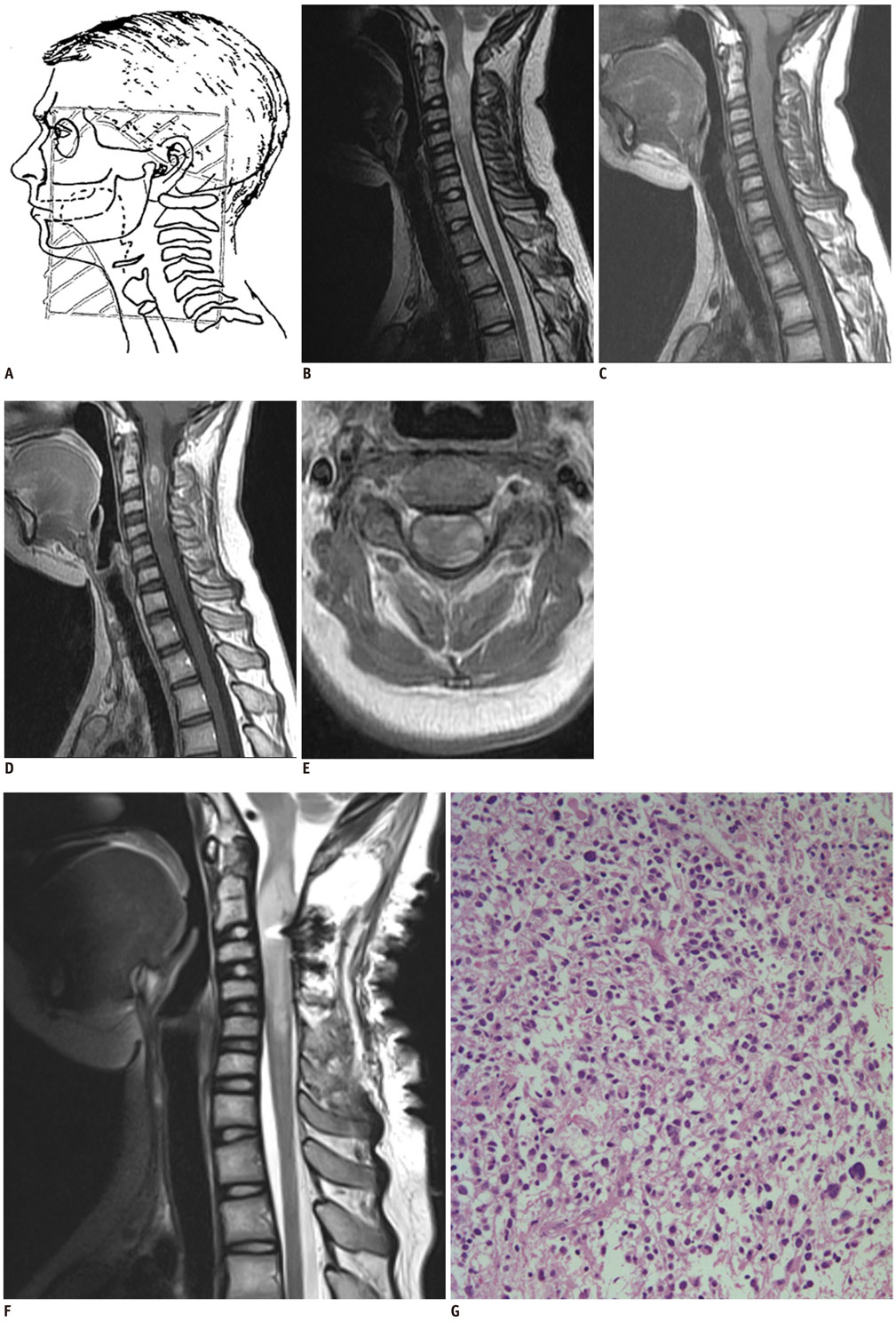Korean J Radiol.
2012 Oct;13(5):652-657. 10.3348/kjr.2012.13.5.652.
Spinal Cord Glioblastoma Induced by Radiation Therapy of Nasopharyngeal Rhabdomyosarcoma with MRI Findings: Case Report
- Affiliations
-
- 1Department of Radiology, Seoul National University College of Medicine, Seoul 110-744, Korea. kimio@snu.ac.kr
- KMID: 1392947
- DOI: http://doi.org/10.3348/kjr.2012.13.5.652
Abstract
- Radiation-induced spinal cord gliomas are extremely rare. Since the first case was reported in 1980, only six additional cases have been reported.; The radiation-induced gliomas were related to the treatment of Hodgkin's lymphoma, thyroid cancer, and medullomyoblastoma, and to multiple chest fluoroscopic examinations in pulmonary tuberculosis patient. We report a case of radiation-induced spinal cord glioblastoma developed in a 17-year-old girl after a 13-year latency period following radiotherapy for nasopharyngeal rhabdomyosarcoma. MRI findings of our case are described.
Keyword
MeSH Terms
-
Contrast Media/diagnostic use
Female
Gadolinium DTPA/diagnostic use
Glioblastoma/*diagnosis/pathology/surgery
Humans
*Magnetic Resonance Imaging
Nasopharyngeal Neoplasms/*radiotherapy
Neoplasms, Radiation-Induced/*diagnosis/pathology
Rhabdomyosarcoma/*radiotherapy
Spinal Cord Neoplasms/*diagnosis/pathology/surgery
Figure
Reference
-
1. Riffaud L, Bernard M, Lesimple T, Morandi X. Radiation-induced spinal cord glioma subsequent to treatment of Hodgkin's disease: case report and review. J Neurooncol. 2006. 76:207–211.2. Bazan C 3rd, New PZ, Kagan-Hallet KS. MRI of radiation induced spinal cord glioma. Neuroradiology. 1990. 32:331–333.3. Ng C, Fairhall J, Rathmalgoda C, Stening W, Smee R. Spinal cord glioblastoma multiforme induced by radiation after treatment for Hodgkin disease. Case report. J Neurosurg Spine. 2007. 6:364–367.4. Pettorini BL, Park YS, Caldarelli M, Massimi L, Tamburrini G, Di Rocco C. Radiation-induced brain tumours after central nervous system irradiation in childhood: a review. Childs Nerv Syst. 2008. 24:793–805.5. Steinbok P. Spinal cord glioma after multiple fluoroscopies during artificial pneumothorax treatment of pulmonary tuberculosis: case report. J Neurosurg. 1980. 52:838–841.6. Kitabatake T, Kurokawa S, Sakai K. A prospective survey on chest malignancies following multiple fluroscopies during artificial pneumothorax therapy for pulmonary tuberculosis. Tohoku J Exp Med. 1976. 118:317–322.7. Myrden JA, Hiltz JE. Breast cancer following multiple fluoroscopies during artificial pneumothorax treatment of pulmonary tuberculosis. Can Med Assoc J. 1969. 100:1032–1034.8. Howe GR. Lung cancer mortality between 1950 and 1987 after exposure to fractionated moderate-dose-rate ionizing radiation in the Canadian fluoroscopy cohort study and a comparison with lung cancer mortality in the Atomic Bomb survivors study. Radiat Res. 1995. 142:295–304.9. Calabrò F, Jinkins JR. MRI of radiation myelitis: a report of a case treated with hyperbaric oxygen. Eur Radiol. 2000. 10:1079–1084.10. Schultheiss TE, Higgins EM, El-Madhi AM. The latent period in clinical radation myelopathy. Int J Radiat Oncol Biol Phys. 1984. 10:1109–1115.11. Alfonso ER, De Gregorio MA, Mateo P, Escó R, Bascón N, Morales F, et al. Radiation myelopathy in over-irradiated patients: MR imaging findings. Eur Radiol. 1997. 7:400–404.12. Uchida K, Nakajima H, Takamura T, Kobayashi S, Tsuchida T, Okazawa H, et al. Neurological improvement associated with resolution of irradiation-induced myelopathy: serial magnetic resonance imaging and positron emission tomography findings. J Neuroimaging. 2009. 19:274–276.
- Full Text Links
- Actions
-
Cited
- CITED
-
- Close
- Share
- Similar articles
-
- Rhabdomyosarcoma of the Spermatic Cord: A Case Report
- A Case of Rhabdomyosarcoma of Spermatic Cord
- A Case of Intramedullary Glioblastoma Multiforme Involving Thoracic Cord in Child
- A Case of Spinal Cord Glioblastoma Multiforme with Intracranial Metastasis
- Primary Spinal Cord Astrocytoma Presenting as Intracranial Hypertension: A Case Report


